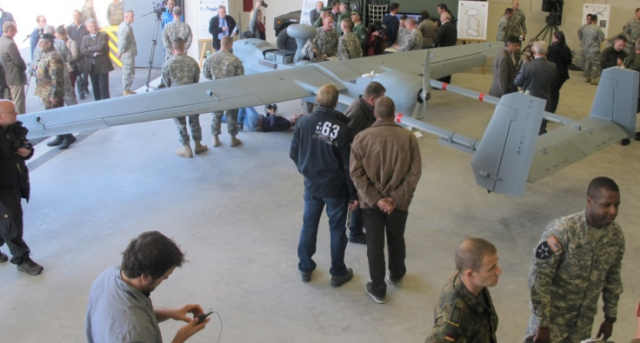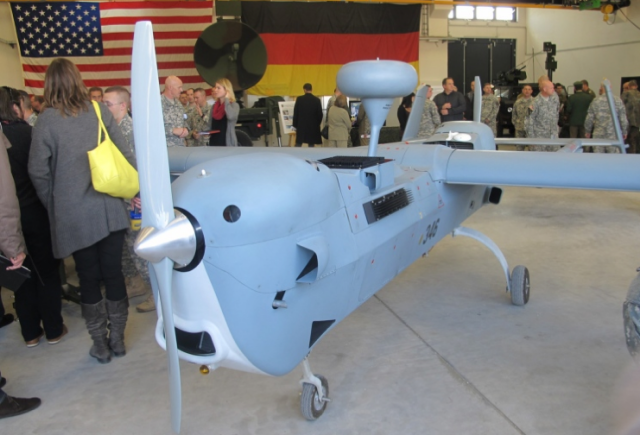 Rest assured, UAS operator Sgt. Carson Wilson says, he’s not here to spy. Next week, a Hunter MQ-5B will be soaring high in a newly established air corridor between the Army’s Grafenwöhr and Hohenfels training areas, marking the first time a US unmanned aircraft will fly beyond military training grounds.
Rest assured, UAS operator Sgt. Carson Wilson says, he’s not here to spy. Next week, a Hunter MQ-5B will be soaring high in a newly established air corridor between the Army’s Grafenwöhr and Hohenfels training areas, marking the first time a US unmanned aircraft will fly beyond military training grounds.
“When I first came to Germany, we didn’t have anywhere to fly,” said Wilson, a UAS operator assigned to the 66th Military Intelligence Brigade. “We’re here to let people know the camera is only to avoid obstacles, not to watch what people are doing.”
On Tuesday, the 7th Army Joint Multinational Training Command and the commander of the U.S. Bavaria Military Community hosted an open house at Vilseck’s Rose Barracks, where the Hunter UAS and a host of other smaller unmanned systems were on display. The event, which attracted a gaggle of local German media, was aimed at informing the public about the new UAS mission in the area and dispelling any safety and privacy concerns associated with the mission.
In July, German aviation authorities approved the use of UAS for training in the greater Grafenwöhr area. While some flights have already begun on training ranges, the Army is now poised to launch flights between training sites. It’s a key milestone for the programme, according to JMTC commander Brig. Gen. Walter Piatt.
“These [UAS] are very important for how we operate around the world today,” Piatt said. “It helps us find the enemy before the enemy finds us.”
During Tuesday’s open house, members of the local media were able to talk with soldiers executing the mission and learn all about the capabilities of the UAS being flown. In the case of the Hunter, the aircraft will typically soar between 11,000 and 14,000 feet on its flight path between Hohenfels and Grafenwöhr, well out of ear shot, Piatt said.
The UAS are all unarmed. The Army in Europe has been working on getting approval for the mission since 2007, according to Piatt. When news began to leak out earlier this summer that the effort was approved, it gave some residents the impression that the Army had something to hide.
“The truth is, some reports came out before we even knew we had approval,” said Piatt, who has since met with numerous local officials about the project.
Meanwhile, the aim of Tuesday’s open house was to dispel the idea that the Army has anything to hide and spotlight the soldiers behind the mission.
“Hopefully, this shows that we aren’t keeping any secrets here,” Piatt said.
For the Army, and other nations training at the JMTC, the ability to coordinate training efforts with UAS reconnaissance support is crucial, commanders said.
“We need to support training the way we do it in the real world environment,” Piatt said.
During the next six months, the effectiveness of the program will be closely monitored. If all goes according to plan, it will become a training feature at the JMTC.
Still, within local communities there remains some ambivalence about the introduction of UAS into German airspace, according to local reporters attending the open house.
While there isn’t a vocal outcry of opposition, there’s an underlying wariness among some residents about surveillance aircraft and what it means for safety and possible privacy infringements, residents say. With the recent revelations from NSA leaker Edward Snowden about U.S. surveillance activities in Europe, those concerns have only intensified.
“It’s a big issue here in general, and it’s a very German topic,” said Constanze Schulze, a reporter for ARD Bavaria. “There are many discussions going on about unmanned units, and of course there is some concern. I think that’s why you see so many reporters here [in Vilseck]. Everyone is talking about it.”
Nonetheless, soldiers on Tuesday sought to reassure their German neighbours. Wilson said the purpose of flying UAS in Germany is to better prepare for missions in places such as Afghanistan.
“It’s a really rewarding feeling when you find an ambush or IED site,” Wilson said of his mission.
Source: Stars & Stripes


Can someone please be so kind and explain to me why this drone can fly in german airspace and the european EuroHawk doesn’t?